The 1960s was a decade of immense change for Kirkcaldy. Change – and not just the smell of linseed oil – was in the air. Linoleum manufacturers were innovating, creating new products and fashionable designs for new and exciting times.
However, the decade also saw the beginnings of sharp decline of linoleum production in Britain. The future of the Fife industry – and the thousands of people who depended on it for work – began to look increasingly bleak.
We’ve just installed a new temporary display in our Moments In Time gallery (on display until 27 October 2022), exploring some of these changes using objects and photographs from our collections.
While creating the display, we’ve been thinking about what it would have been like to live in Kirkcaldy during this uncertain time. As the fortunes of the linoleum industry began to shift, what did people feel, what did they see – and what music did they listen to?
Why music? Have you ever been going about your life, and heard a song – in a shop, on the TV, on the radio – and been instantly transported to another time when you heard, sang or danced to that song? Last week I was in a pub where a Red Hot Chili Peppers song was playing, and immediately remembered driving in the car with my dad, singing to the same song and holding my hand out of the open window. Something like this has probably happened to you too.
With music from times and places which we didn’t experience, music can have a slightly different effect. It’s easy to forget that people in the past – whether it’s the 1960s or the 1560s – were essentially the same as we are now. They had the same thoughts, feelings, likes and dislikes. Listening to music from those times, regardless of whether we know the songs, help us to remember that, and to better understand our history.
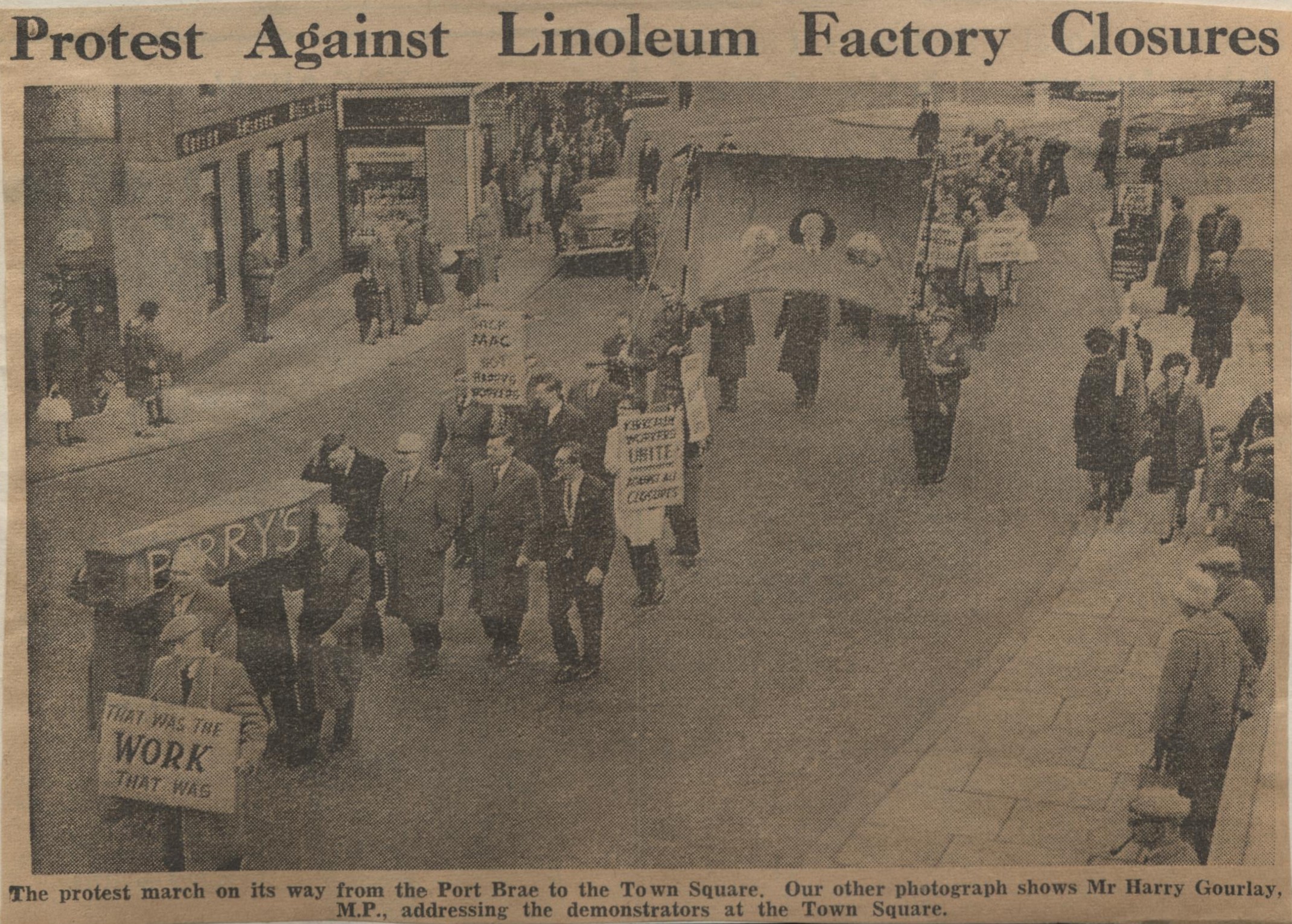
Newspaper cutting from the Local Studies collection at Kirkcaldy Galleries.
So, we created this playlist as a bit of an experiment: to help those of you who were in Kirkcaldy during the 1960s remember the time more clearly, and to help those of us who weren’t to imagine what it might have been like. If you have a Spotify account, you can listen here. If not, click here to listen on Youtube. Without further ado, here it is:
1. (If I Say I Love You) Do You Mind? – Anthony Newley
2. Walking Back to Happiness – Helen Schapiro
3. Moon River – Danny Williams
The first three songs on the playlist were all hits in the UK between January 1960 and December 1961 – we picked them to correspond to the three samples of linoleum in the display. These songs don’t mirror the psychedelic influences in the linoleum designs, but they do represent a world on the cusp of a huge change. The new genres and styles of music which would become popular in the next few years – namely rock and roll – would come to dominate more traditional pop music.
4. Lovesick Blues – Frank Ifield
But, before we embrace change wholeheartedly, let’s indulge in a little yodelling. This song – made famous by Hank Williams in 1952 (and then again by Mason Ramsey AKA ‘the yodelling kid’ in 2018) was a hit in 1962, when customers from Kirkcaldy to Kings Lynn were covering their floors with designs from this pattern book. While it’s still a quite traditional ditty, we liked the imagining happy lino owners square dancing on their newly laid kitchen floors (and thought you might like to imagine it too).
This song was playing across the UK in 1963, and was at its most popular at the time the news of the Barry’s redundancies was announced in the Fife Free Press in April. It’s a very upbeat tune, and we were sort of hoping for something more in-keeping with the sadness many people in Kirkcaldy would have felt. Ultimately though, we decided to keep it in – it’s important to remember that the rest of the world doesn’t automatically follow suit during dark times.
6. From Me To You – The Beatles
Finally, the Beatles. This playlist would have been empty without them, as the band have quite a few connections to Kirkcaldy, and to our linoleum collection. This song would have been heard across Kirkcaldy the day of the Barry’s march in May 1963, and the band would play a show at the Carlton Cinema on Park Road just months later.
7. She’s Not You – Elvis Presley
Though we tended towards British artists when making our selections, we’d have been remiss if we didn’t include a bit of Elvis. As one of the most iconic voices of the decade, we were sure that people in Kirkcaldy must have been singing this song as events unfolded. This song was a hit when Nairn’s announced that they would be merging with rival firm Williamson’s in September 1962, a move which was finalised in the winter of 1963.
Like other Kirkcaldy firms, Nairn’s was forced to downsize, diversify and consolidate its business during the 1960s. The decision to merge with Williamson’s, however, may have been what saved it from a full closure; unlike Barry’s, its Kirkcaldy production survived the decade.
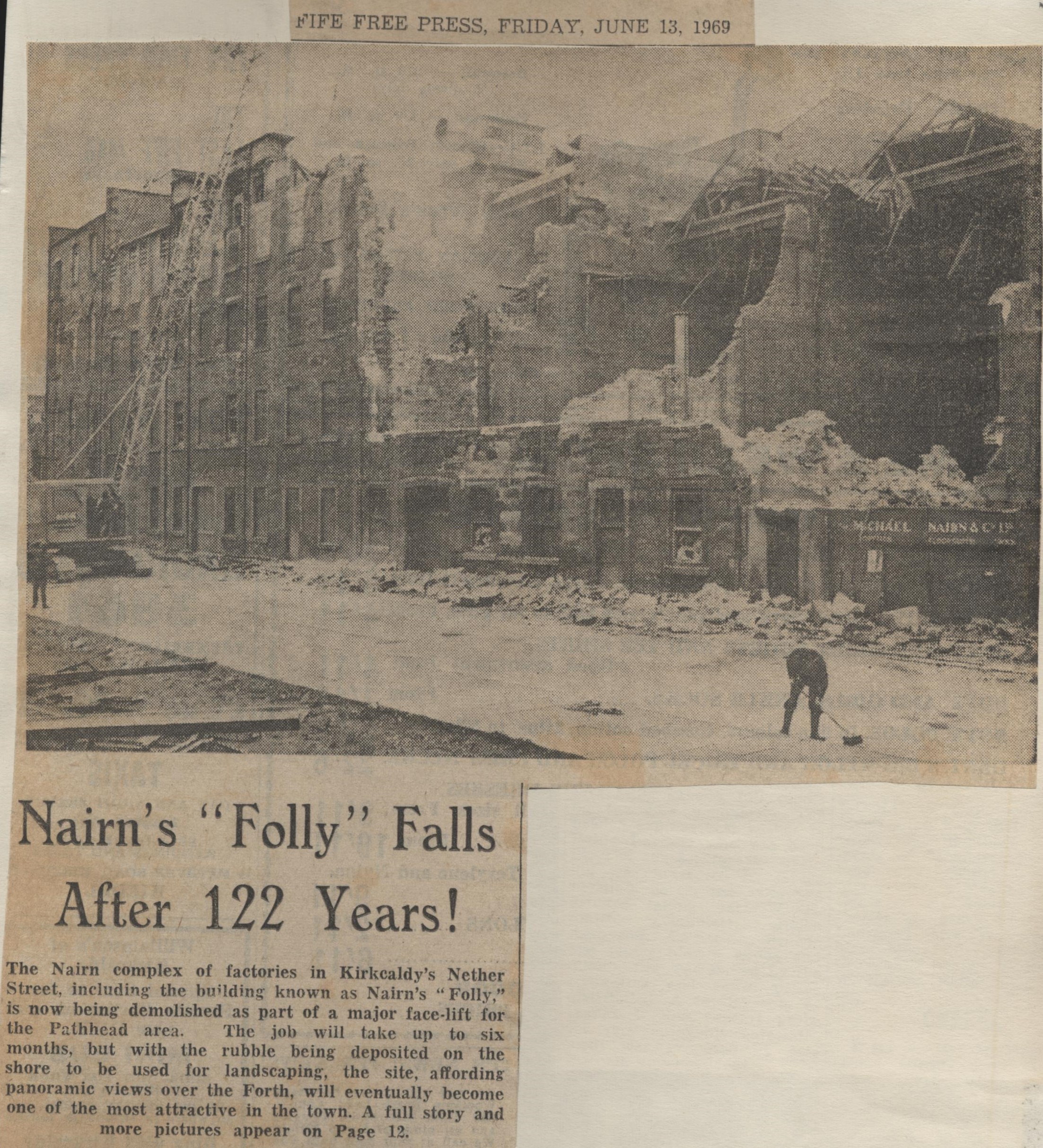
Newspaper cutting from the Local Studies collection at Kirkcaldy Galleries.
8. Where Do You Go To – Peter Sarstedt
From 1969, linoleum factories began to disappear from Kirkcaldy en-masse. The Barry’s factory complex, which had been mainly concentrated around the train station – was demolished in 1969. This completely changed the shape of the town; the queer like smell that had announced the town to visitors arriving on the rails for a hundred years was beginning to fade as the buildings were levelled. The area today is unrecognisable.
Not long after, the Nairn’s Pathhead complex suffered the same fate. This included the original ‘Nairn’s Folly’ building – a relic of the beginning of the floorcovering industry in Kirkcaldy. For residents of the town, this must have seemed a particularly bad omen.
This song was a hit earlier in the year, but we felt its melancholy, nostalgic tone seemed to fit well with the way the demolition of the Kirkcaldy linoleum factories made us feel – and perhaps made those in the town at the time feel, too.
This the first time we’ve used music to supplement our displays, and we’d love to know what you think. If this has prompted any thoughts or memories, or if you have any feedback you would like to share, you can e-mail Lily (Flooring The World Engagement Curator) at lino@onfife.com
_________
This blog was written by Lily Barnes, curator working on the linoleum project Flooring the World (2022-2024). Flooring the World is a two-year project exploring the history of the Fife linoleum industry. It is funded by the Esmée Fairbairn Collections Fund, which is run by the Museums Association, funding projects that develop collections to achieve social impact.



Image: A pattern book. KIRMG:1992.0267
This is a pattern book, produced by Nairn’s of Kirkcaldy in 1930. It contains full-colour images of the linoleum designs produced by the company in that year, and would have been made available for customers to browse before they made their selection.
We have over fifty of these in our collections, dating from the mid 19th century to the 1960s. As we continue to accession the Forbo Factory archive, modern brochures join this collection to allow us to view linoleum as potential customers have for 150 years. While the way in which linoleum is made has changed little in that time, the styles sought after by and available to customers have changed dramatically.
20th and 21st century designs tend to be more general in their function; today, Forbo brochures showcase marbled-pattern linoleums in a kaleidoscope of colours, fit for every style and season.
However, our 19th century pattern books contain designs created with specific spaces in mind. One features a border of cues and billiard balls for a games room, and the inclusion of the word ‘Salve’ (the Latin for ‘welcome’) in this classical design points towards its being intended for an entrance hall. The room in the house which seems to have generated the most elaborate space-specific designs, however, is the nursery.

Images: Two pages from FIFER:2022.0150.
Today, we associate linoleum in the home mainly with kitchens and bathrooms; in the 19th and early 20th centuries, it (along with its forerunner floorcloth) could be found in any room. So, with all these rooms to choose from, why designs intended specifically for the nursery? This trend was dependent on two key social developments in the late Victorian period. The first, as strange as it sounds, was the invention of childhood.
Prior to this time, the common consensus was that there was nothing special about being a child. Children wore miniature versions of adults’ clothes and contributed economically to the family by working. They were seen as miniature versions of the grown-ups they would become – with any variations from adulthood being seen as passing nuisances.
In the mid 19th century however, improving economic conditions and the rise of the middle-classes meant that it was not always essential for children to work to support a household. Life before adulthood became associated with leisure, play, and innocence. Rather than a temporary state of smallness, childhood became something to be cherished and protected.
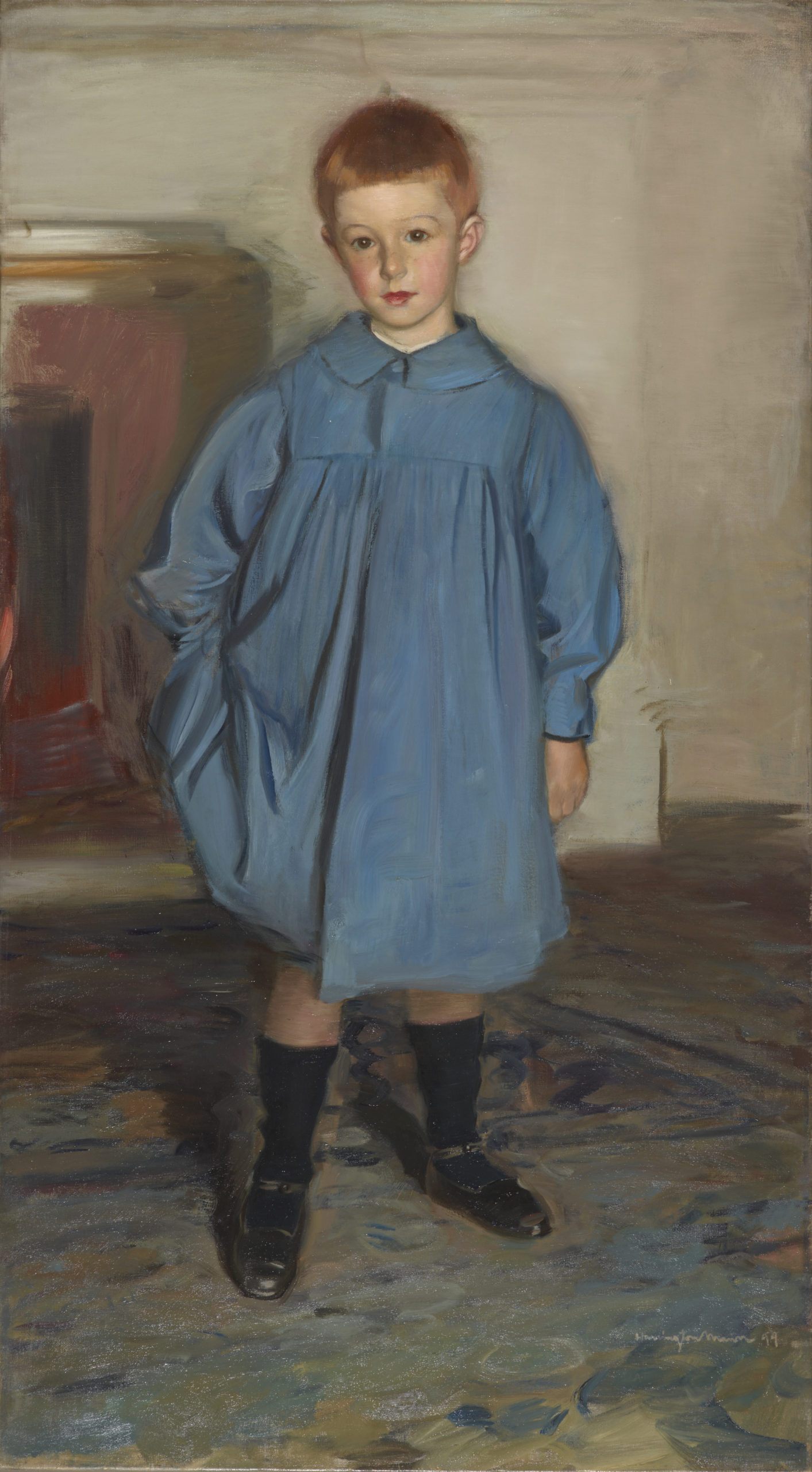
Image: Portrait of Ian Couper Nairn, by Harrington Mann. KIRMG:383. The children of the Nairn family – Kirkcaldy’s original linoleum manufacturers – had their portraits painted in 1899. They would’ve been among the first generations of children raised according to new notions of childhood. In this portrait, we see Ian Couper Nairn standing in an interior – perhaps a glimpse into his linoleum floored nursery?
This same economic improvement brings us to the second change: a greater separation between work and the home.
Due to British imperialism, this period was marked by accelerated industrialisation. As the shape of work changed, so too did the shape of the workplace. Towns and cities across the country became filled with factories and warehouses – transforming raw materials and storing finished goods extracted from overseas territories – and offices to manage these global businesses. Britain grew rich by travelling beyond its shores, exploiting the people and lands of its acquired territories. As a result of this, middle-class families were able to mirror this expansionist impulse, travelling beyond their homes to new, modern workspaces.
On a practical level, this meant that many middle-class Briton’s now found themselves with more space in their houses. So, as childhood became a precious, protected time in a person’s life, the home became a special place reserved for leisure, relaxation and the family (though each of these privileges was dependent on being born into a family wealthy and stable enough to afford them). The extra space in the home therefore naturally became a place exclusively reserved for children: the nursery.
This meant that there was suddenly a new market to be catered to. However, the idea that children will have at least some say in how their spaces are decorated is a relatively new one. So – while children would undoubtedly have enjoyed them – these patterns were primarily designed to cater to the adults who would be purchasing them.
More specifically, they appealed to women. Though men’s work had left the home, women’s labour remained. As the home began to change shape (and size) in response to these social and economic changes, a new task emerged for the middle-class Victorian – the creation and cultivation of a tasteful interior.
Whereas once, home furnishings beyond the functional and comfortable were the preserve of the upper-classes, middle-class homes were now also expected to be finished in the latest fashion. From the 1860s, ‘homemaking’ became a respectable pastime for well-to-do women, joining the ranks of other sanctioned hobbies such as album-making, crafting faux flowers, and fern collecting. Each of these hobbies was seen as distinctly feminine, and as exercises by which women could cultivate their finest ‘womanly’ traits and, by extension, their morality. They required quiet, rewarded perfectionism and patience, and encouraged the contemplation of the meek and delicate.
Homemaking fulfilled a similar function, but with a crucial difference. Whereas these other crafts resulted in small, hidable products, home décor was a comparatively public medium for self-expression – or, more accurately then as today, an expression of the self one wished to impress on others. An ill-pasted page in an album could be avoided; an unkempt, poorly appointed room was for all to see.
Alongside creating a home which was fashionable and comfortable, therefore, the middle-class Victorian woman also had to make sure her home décor choices conveyed her unblemished character. This meant, of course, that it had to be clean.
In the 19th century cleanliness was truly next to godliness; any evidence of dirt or wear was surely a sign of loose character. Here then, the Victorian woman was in a bind. To be a ‘good’ wife, it was expected (perhaps even necessitated in an era with paltry access to contraception) that she have children. However, that goodness would be easily undermined by mess which naturally accompanied those children. The solution to this problem was – you guessed it – linoleum.

Images: This advert for Forshaga linoleum (left; FIFER:2022.0201) touts the floorcoverings virtues in relation to the body of the housewife. In Kirkcaldy (right, TEMP:2011.4263), a slightly different tactic was used to emphasise linoleum as a labour-saving innovation. This advert by Nairn’s impresses that its products are dry-wipe using the cute metaphor of puppies and kittens rather than the unpleasant reality of the messes all young animals – including nursery-bound humans – make.
The hygienic qualities of linoleum have always been central to its appeal, and the same was true in the 19th century. Linoleum was quicker and easier to clean than traditional floorcoverings, and this was exploited in adverts, such as this one produced by Swedish manufacturers Forshaga.
The stress of cleaning a wooden floor is obvious in the face of the woman scrubbing them who – with her muscular arms and messy hair – is coded as working-class. The leisured middle-class homemaker on the right does not have to spoil her appearance or her delicate, idealised figure with such labour: she has linoleum. Linoleum, therefore, was a good and proper thing for Victorian women – indeed, it would help them preserve their status by ensuring that their homes and bodies conformed to class and gender norms.
If dirt and mess was a visual sign of moral decay, noise of any kind warned the ear of bad character. Here too, linoleum had the edge over wooden, stone or tiled floors. Linoleum – particularly thicker and more expensive varieties such as cork carpet – muffled the sounds of toys bounced, dragged or skittered across it (while also resisting any marks they might make). It was also more forgiving on toddling, crawling bodies – which (theoretically) meant less crying. Childhood was precious – but children were still meant to be seen and not heard.
Once a Victorian woman was certain she had a clean and moral home, she had to turn her mind to the future – and that meant education. It was up to her to impress both knowledge and upright values on her young charges – and linoleum – it was hoped – would shape the futures of the small humans who walked on it.
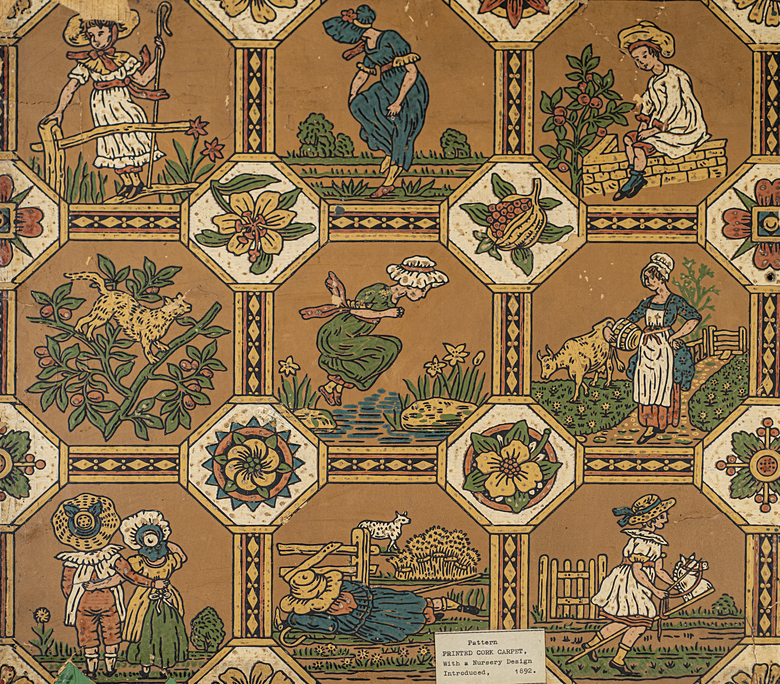
Image: This cork carpet design, dating from 1892, shows children playing in an imagined countryside. At a time when the industrialisation which made floorcoverings like these and the nurseries which housed them possible, there was a strong popular taste for images of a rural life which was imagined as simpler and more innocent than modern cities – just as childhood became seen as simpler and more innocent than adulthood. FIFER:2022.0174
The floorcoverings designed for nurseries served as teaching tools as well as decoration. Writer Samuel Smiles stressed the importance of visible examples of good behaviour, insisting that these were far more impactful than mere explanation. More was at stake than just a peaceful homelife; for Smiles, “the nation [came] from the nursery” – the health and strength of the country depended on children knowing clearly what was expected of them.
To do this, floorcovering designs borrowed heavily from other media created with children in mind. Illustrated books produced by English artists Kate Greenaway and Walter Crane clearly had a strong influence on the designs in our collections.
The design above clearly mimics Greenaway’s style. It epitomises the idealised childhood of the time – well-behaved, flaxen-haired children frolic unsupervised in a colourful, pastoral idyll. Their world is unblemished by signs of work or modernity; their play is neat and innocent. Children surrounded by these designs surely could not help but follow their example, as Smiles hoped.
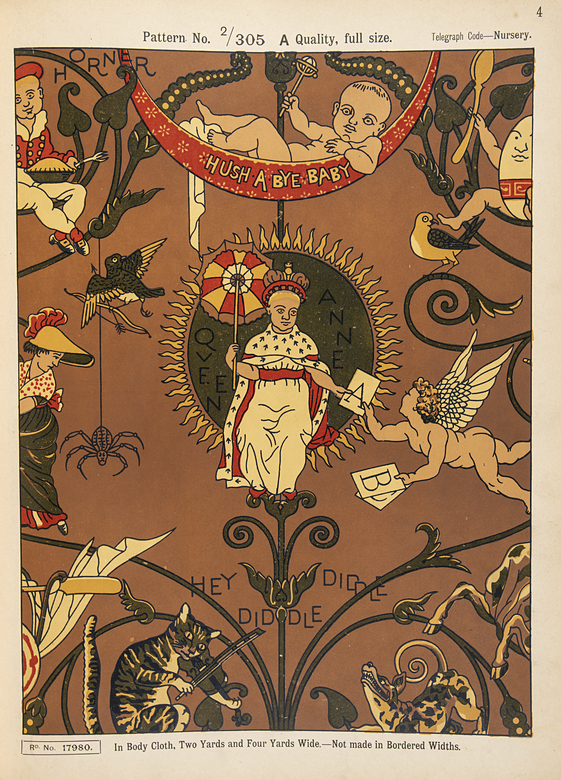
Image: In a pattern book produced by the Kirkcaldy Linoleum Company, 1876 – c.1900. Though the colours differ from Crane’s wallpaper, the rest of the design is identical. Though most of these nursery rhymes have stood the test of time, the central song ‘Letters to Queen Anne’ appears to have faded away from the nursery in the 20th century. FIFER:2022.0150
Another theme favoured by interior design writers, consumers and manufacturers alike was nursery rhymes. This design by Walter Crane was commissioned by Jeffrey and Co. in 1876; examples of this paper – both in a predominantly blue and yellow colour scheme – survive in the collections of the V&A and the Cooper Hewitt Museum. We don’t know exactly when it was adapted by the Kirkcaldy Linoleum Company, but the fact that it was is testament to its popularity.
Pictures in rooms used by children served the same purpose then as they do now: to provide bright and colourful memory aids to assist learning and lend rhythm to group games and activities. Children living in industrial cities might not venture into a Greenaway-esque countryside, but they would still learn to tell a cow from a spoon in a well-appointed Victorian nursery, as well as maybe learning a bit of the alphabet.
All of this together meant that, from the mid-19th century, the physical reality of the Victorian home – its fixtures, fittings and decoration – was seen as an essential to the moral, intellectual, and physical health of the nation and its Empire. While the interior home was important, this project started from the bottom up – both in terms of beginning in childhood, and beginning with an appropriate floorcovering. Given the high stakes, is it any wonder linoleum companies designed products specifically for the nursery?
_________
This blog was written by Lily Barnes, curator working on the linoleum project Flooring the World (2022-2024). Flooring the World is a two-year project exploring the history of the Fife linoleum industry. It is funded by the Esmée Fairbairn Collections Fund, which is run by the Museums Association, funding projects that develop collections to achieve social impact.


If you have any questions or information you’d like to share, you can get in touch at lino@onfife.com
